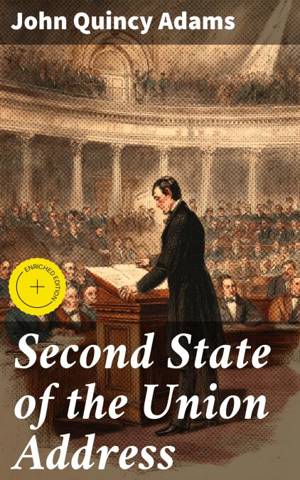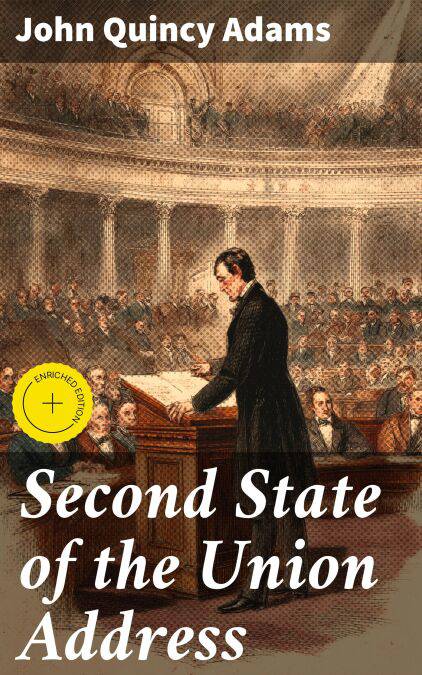
- Afhalen na 1 uur in een winkel met voorraad
- Gratis thuislevering in België vanaf € 30
- Ruim aanbod met 7 miljoen producten
- Afhalen na 1 uur in een winkel met voorraad
- Gratis thuislevering in België vanaf € 30
- Ruim aanbod met 7 miljoen producten
Zoeken
Second State of the Union Address E-BOOK
Enriched edition. Shaping a Nation: Insights from America's Past State of the Union Address
John Quincy Adams
E-book | Engels
€ 1,99
+ 1 punten
Omschrijving
John Quincy Adams' "Second State of the Union Address," delivered in 1826, presents a compelling examination of the political landscape of early America, woven with Adams' characteristic eloquence and profound insight. This address not only articulates his vision for the nation but also addresses pressing issues such as international relations, the internal development of the Republic, and the moral imperatives guiding its expansion. Through a detailed and articulate prose style, Adams artfully navigates the complexities of governance, emphasizing unity, national security, and the pursuit of liberty in a rapidly changing world. As the sixth President of the United States and a prominent diplomat, John Quincy Adams was deeply influenced by the ideals of the American Revolution and the ongoing debates about the nation's future. His experiences, including his role in formulating key policies and as a notable advocate for abolition, shaped his belief in an informed citizenry and robust governmental responsibility. Adams' intellectual rigor reflects his commitment to democracy and moral integrity, positioning him as a key figure in the progressive narrative of American history. For readers fascinated by the foundations of American political thought and the intricate interplay between leadership and ethics, Adams' "Second State of the Union Address" is an invaluable resource. It invites contemporary readers to reflect on the values that shaped the nation and remains pivotal as we navigate modern political dilemmas, making it essential for anyone interested in the enduring principles of democracy.
In this enriched edition, we have carefully created added value for your reading experience:
- A succinct Introduction situates the work's timeless appeal and themes.
- The Synopsis outlines the central plot, highlighting key developments without spoiling critical twists.
- A detailed Historical Context immerses you in the era's events and influences that shaped the writing.
- An Author Biography reveals milestones in the author's life, illuminating the personal insights behind the text.
- A thorough Analysis dissects symbols, motifs, and character arcs to unearth underlying meanings.
- Reflection questions prompt you to engage personally with the work's messages, connecting them to modern life.
- Hand‐picked Memorable Quotes shine a spotlight on moments of literary brilliance.
- Interactive footnotes clarify unusual references, historical allusions, and archaic phrases for an effortless, more informed read.
In this enriched edition, we have carefully created added value for your reading experience:
- A succinct Introduction situates the work's timeless appeal and themes.
- The Synopsis outlines the central plot, highlighting key developments without spoiling critical twists.
- A detailed Historical Context immerses you in the era's events and influences that shaped the writing.
- An Author Biography reveals milestones in the author's life, illuminating the personal insights behind the text.
- A thorough Analysis dissects symbols, motifs, and character arcs to unearth underlying meanings.
- Reflection questions prompt you to engage personally with the work's messages, connecting them to modern life.
- Hand‐picked Memorable Quotes shine a spotlight on moments of literary brilliance.
- Interactive footnotes clarify unusual references, historical allusions, and archaic phrases for an effortless, more informed read.
Specificaties
Betrokkenen
- Auteur(s):
- Uitgeverij:
Inhoud
- Aantal bladzijden:
- 21
- Taal:
- Engels
Eigenschappen
- Productcode (EAN):
- 4064066312985
- Verschijningsdatum:
- 7/12/2020
- Uitvoering:
- E-book
- Beveiligd met:
- Digital watermarking
- Formaat:
- ePub

Alleen bij Standaard Boekhandel
+ 1 punten op je klantenkaart van Standaard Boekhandel
Beoordelingen
We publiceren alleen reviews die voldoen aan de voorwaarden voor reviews. Bekijk onze voorwaarden voor reviews.








